Space Shuttle Videos
|
Loading...
|
|
Space Shuttle
Space Shuttle Discovery launches at the start of STS-120.
Manufacturer: United Space Alliance:
Thiokol/Alliant Techsystems (SRBs)
Lockheed Martin (Martin Marietta) - (ET)
Rockwell/Boeing (orbiter)
Country of origin: United States
Size:
Height: 184.2 ft (56.1 m)
Diameter: 28.5 ft (8.7 m)
Mass: 4,470,000 lbm (2,030 t)
Capacity:
Payload to LEO: 24,400 kg (53,600 lb)
Payload to
GTO: 3,810 kg (8,390 lbm)
Payload to
Polar orbit: 12,700 kg (28,000 lb)
Launch history:
Status: Active
Launch sites: LC-39, Kennedy Space Center
SLC-6, Vandenberg AFB (unused)
Total launches: 132
Successes: 131
Failures: 1 (launch failure, Challenger)
Other: 1 (re-entry failure, Columbia)
Maiden flight: April 12, 1981
Notable payloads: Tracking and Data Relay Satellites
Spacelab
Great Observatories (including Hubble)
Galileo, Magellan, Ulysses
Mir Docking Module
ISS components
Boosters (Stage 0) - Solid Rocket Boosters:
â boosters: 2
Engines: 1 solid
Thrust: 2,800,000 lbf each, sea level liftoff (12.5 MN)
Specific impulse: 269 s
Burn time: 124 s
Fuel: solid
First stage - External Tank:
Engines: 3 SSMEs located on Orbiter
Thrust: 1,225,704 lbf total, sea level liftoff (5.45220 MN)
Specific impulse: 455 s
Burn time: 480 s
Fuel: LOX/LH2
Second stage - Orbiter:
Engines: 2 OME
Thrust: 53.4 kN combined total vacuum thrust (12,000 lbf)
Specific impulse: 316 s
Burn time: 1250 s
Fuel: MMH/N2O4
The Space Shuttle, or Space Transportation System (STS), is a reusable launch system and orbital spacecraft operated by the U.S. National Aeronautics and Space Administration (NASA) for human spaceflight missions. The system combines rocket launch, orbital spacecraft, and re-entry spaceplane with modular add-ons. The first of four orbital test flights occurred in 1981 leading to operational flights beginning in 1982. The system is scheduled to be retired from service in 2011 after 135 launches. Major missions have included launching numerous satellites and interplanetary probes, conducting space science experiments, and servicing and construction of space stations.
It has been used for orbital space missions by NASA, the U.S. Department of Defense, the European Space Agency, Japan, and Germany. The United States funded STS development and shuttle operations except for Spacelab D1 and D2 - sponsored by West Germany and reunified Germany respectively. In addition, SL-J was partially funded by Japan.
At launch, the Space Shuttle consists of the shuttle stack, which includes a dark orange-colored external tank (ET); two white, slender Solid Rocket Boosters (SRBs); and the Orbiter Vehicle (OV), which contains the crew and payload. Payloads can be launched into higher orbits with either of two different booster stages developed for the STS (single-stage Payload Assist Module or two-stage Inertial Upper Stage). The Space Shuttle is "stacked" in the Vehicle Assembly Building and the stack mounted on a mobile launch platform held down by four explosive bolts on each SRB which are detonated at launch.
The shuttle stack launches vertically, like a conventional rocket, from a mobile launch platform. It lifts off under the power of its two SRBs and the three main engines, which are fueled by liquid hydrogen and liquid oxygen from the external tank. The Space Shuttle has a two-stage ascent. The SRBs provide additional thrust during liftoff and first-stage flight. About two minutes after liftoff, explosive bolts are fired, releasing the SRBs, which then parachute into the ocean, to be retrieved by ships for refurbishment and reuse. The shuttle orbiter and external tank continue to ascend on an increasingly horizontal flight path under power from the three main engines. Upon reaching 17,500 mph (7.8 km/s), necessary for low Earth orbit, the main engines are shut down. The external tank is then jettisoned downward to burn up in the atmosphere. It is, however, possible for the external tank to be re-used in orbit. After jettisoning the external tank, the orbital maneuvering system (OMS) engines may be used to adjust the orbit.
The orbiter carries astronauts and payload such as satellites or space station parts into low earth orbit, into the Earth's upper atmosphere or thermosphere. Usually, five to seven crew members ride in the orbiter. Two crew members, the Commander and Pilot, are sufficient for a minimal flight, as in the first four "test" flights, STS-1 through STS-4. A typical payload capacity is about 22,700 kilograms (50,000 lb), but can be raised depending on the choice of launch configuration. The orbiter carries the payload in a large cargo bay with doors that open along the length of its top, a feature which makes the Space Shuttle unique among present spacecraft. This feature made possible the deployment of large satellites such as the Hubble Space Telescope, and also to capture and return large payloads back to Earth.
When the orbiter's space mission is complete, it fires its OMS thrusters to drop out of orbit and re-enter the lower atmosphere. During the descent, the shuttle orbiter passes through different layers of the atmosphere and decelerates from hypersonic speed primarily by aerobraking. In the lower atmosphere and landing phase, it is more like a glider but with reaction control system (RCS) thrusters and fly-by wire controlled hydraulically actuated flight surfaces controlling its descent. It then makes a landing on a long runway as a spaceplane. The aerodynamic shape is a compromise between the demands of radically different speeds and air pressures during re-entry, hypersonic flight, and subsonic atmospheric flight. As a result, the orbiter has a relatively high sink rate at low altitudes, and transitions during re-entry from using RCS thrusters in low pressure to flight surfaces at low altitudes.
Early history
Though design and construction of the Space Shuttle began in the early 1970s, conceptualization actually began two decades earlier, even before the Apollo program of the 1960s. The concept of a spacecraft returning from space to a horizontal landing began within NACA, in 1954, in the form of an aeronautics research experiment later named the X-15. The NACA proposal was submitted by Walter Dornberger.
In 1958, the X-15 concept further developed into another X-series spaceplane proposal, called the X-20, which was never constructed. Neil Armstrong was selected to pilot both the X-15 and the X-20. Though the X-20 was never built, another spaceplane similar to the X-20 was built several years later and delivered to NASA in January 1966. It was called the HL-10. "HL" indicated "horizontal landing".
In the mid-1960s, the US Air Force conducted a series of classified studies on next-generation space transportation systems and concluded that semi-reusable designs were the cheapest choice. They proposed a development program with an immediate start on a "Class I" vehicle with expendable boosters, followed by slower development of a "Class II" semi-reusable design and perhaps a "Class III" fully reusable design later. In 1967 George Mueller held a one-day symposium at NASA headquarters to study the options. Eighty people attended and presented a wide variety of designs, including earlier Air Force designs as the Dyna-Soar (X-20).
In 1968, NASA officially began work on what was then known as the "Integrated Launch and Re-entry Vehicle" (ILRV). At the same time, NASA held a separate Space Shuttle Main Engine (SSME) competition. NASA offices in Houston and Huntsville jointly issued a Request for Proposal (RFP) for ILRV studies to design a spacecraft that could deliver a payload to orbit but also re-enter the atmosphere and fly back to Earth. One of the responses was for a two-stage design, featuring a large booster and a small orbiter, called the DC-3.
In 1969, President Richard Nixon decided to proceed with Space Shuttle development. In August 1973, the X-24B proved that an unpowered spaceplane could re-enter Earth's atmosphere for a horizontal landing.
Description
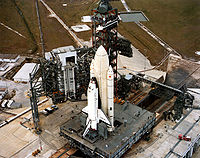
Picture - STS-1 on the launchpad (1981)
The Space Shuttle is the first orbital spacecraft designed for reuse. It carries different payloads to low Earth orbit, provides crew rotation for the International Space Station (ISS), and performs servicing missions. The orbiter can also recover satellites and other payloads from orbit and return them to Earth. Each Shuttle was designed for a projected lifespan of 100 launches or ten years of operational life, although this was later extended. The person in charge of designing the STS was Maxime Faget, who had also overseen the Mercury, Gemini, and Apollo spacecraft designs. The crucial factor in the size and shape of the Shuttle Orbiter was the requirement that it be able to accommodate the largest planned commercial and classified satellites, and have the cross-range recovery range to meet the requirement for classified USAF missions for a once-around abort from a launch to a polar orbit. Factors involved in opting for solid rockets and an expendable fuel tank included the desire of the Pentagon to obtain a high-capacity payload vehicle for satellite deployment, and the desire of the Nixon administration to reduce the costs of space exploration by developing a spacecraft with reusable components.
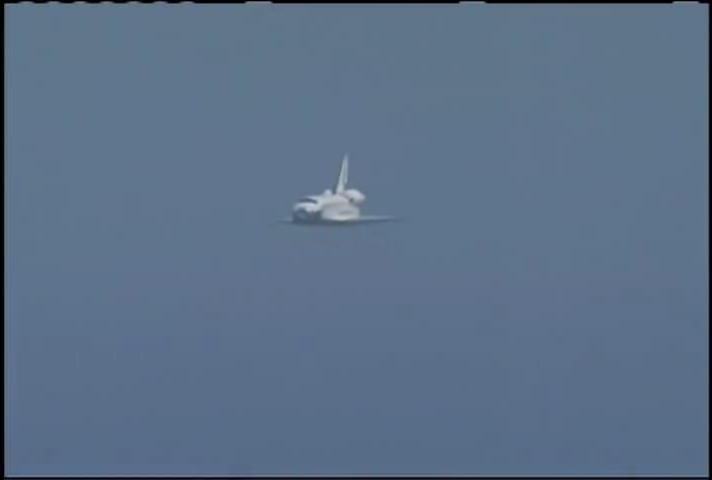
Picture - STS-127, Space Shuttle Endeavour landing video (2009)
Each Space Shuttle is a reusable launch system that is composed of three main assemblies: the reusable Orbiter Vehicle (OV), the expendable external tank (ET), and the two reusable solid rocket boosters (SRBs). Only the orbiter enters orbit shortly after the tank and boosters are jettisoned. The vehicle is launched vertically like a conventional rocket, and the orbiter glides to a horizontal landing like an airplane, after which it is refurbished for reuse. The SRBs parachute to splashdown in the ocean where they are towed back to shore and refurbished for later shuttle missions.
Six airworthy orbiters have been built; the first, Enterprise (OV-101), was not built for orbital space flight, and was used only for testing glide and landing. Five space-worthy orbiters were built: Columbia (OV-102), Challenger (OV-099), Discovery (OV-103), Atlantis (OV-104), and Endeavour (OV-105). Enterprise was originally intended to be made fully space-worthy after use for the approach and landing test (ALT) program, but it was found more economical to upgrade the structural test article STA-099 into orbiter Challenger (OV-099). Challenger disintegrated 73 seconds after launch in 1986, and Endeavour was built as a replacement for Challenger from structural spare components. Columbia broke apart during re-entry in 2003. Building Space Shuttle Endeavour cost about US$1.7 billion. One Space Shuttle launch costs around $450 million.
Roger A. Pielke, Jr. has estimated that the Space Shuttle program has cost about US$170 billion (2008 dollars) through early 2008. This works out to an average cost per flight of about US$1.5 billion. However, two missions were paid for by Germany, Spacelab D1 and D2 (D for Deutschland) with a payload control center in Oberpfaffenhofen, Germany. D1 was the first time that control of a manned STS mission payload was not in U.S. hands.
At times, the orbiter itself is referred to as the Space Shuttle. Technically, this is a slight misnomer, as the actual "Space Transportation System" (Space Shuttle) is the combination of the orbiter, the external tank, and the two solid rocket boosters. Combined, these are referred to as the "Stack"; the components are assembled in the Vehicle Assembly Building, which was originally built to assemble the Apollo Saturn V rocket stacks.
Space Shuttle Atlantis transported by a Boeing 747 Shuttle Carrier Aircraft (SCA), 1998 (NASA).
Space Shuttle Endeavour being transported by a Boeing 747.
An overhead view of Atlantis as it sits atop the Mobile Launcher Platform (MLP) before STS-79. Two Tail Service Masts (TSMs) to either side of the orbiter's tail provide umbilical connections for propellant loading and electrical power.
Water is released onto the mobile launcher platform on Launch Pad 39A at the start of a sound suppression system test in 2004. During launch, 300,000 US gallons (1,100 m³) are poured onto the pad in only 41 seconds.
Orbiter vehicle
The orbiter resembles a conventional aircraft, with double-delta wings swept 81° at the inner leading edge and 45° at the outer leading edge. Its vertical stabilizer's leading edge is swept back at a 50° angle. The four elevons, mounted at the trailing edge of the wings, and the rudder/speed brake, attached at the trailing edge of the stabilizer, with the body flap, control the orbiter during descent and landing.
The orbiter has a large payload bay measuring 15 by 60 feet (4.6 by 18 m) comprising most of the fuselage. Two mostly symmetrical lengthwise payload bay doors hinged on either side of the bay comprise its entire top. Payloads are generally loaded horizontally into the bay while the orbiter is oriented vertically on the launch pad and unloaded vertically in the near-weightless orbital environment by the orbiter's robotic remote manipulator arm (under astronaut control), EVA astronauts, or under the payloads' own power (as for satellites attached to a rocket "upper stage" for deployment.)
Three Space Shuttle main engines (SSMEs) are mounted on the orbiter's aft fuselage in a triangular pattern. The three engine nozzles can swivel 10.5 degrees up and down, and 8.5 degrees from side to side during ascent to change the direction of their thrust to steer the shuttle. The orbiter structure is made primarily from aluminum alloy, although the engine structure is made primarily from titanium alloy.
The orbiter can be used in conjunction with a variety of add-ons depending on the mission. This has included orbital laboratories (Spacelab, Spacehab), boosters for launching payloads farther into space (Inertial Upper Stage, Payload Assist Module), and other add-ons like the Extended Duration Orbiter, Multi-Purpose Logistics Modules, and Canadarm (RMS).
The space-capable orbiters built are OV-102 Columbia, OV-099 Challenger, OV-103 Discovery, OV-104 Atlantis, and OV-105 Endeavour.
Orbiter add-ons:
MPLM Leonardo
IUS deploying with Galileo
PAM-D with satellite
EDO being installed
Spacelab in orbit
RMS (Canadarm)
External tank
The main function of the Space Shuttle external tank is to supply the liquid oxygen and hydrogen fuel to the Space Shuttle main engines. It is also the backbone of the launch vehicle providing attachment points for the two Solid Rocket Boosters and the Orbiter. The external tank is the only part of the shuttle system that is not reused. Although the external tanks have always been discarded, it is possible to take them into orbit and re-use them (such as for incorporation into a space station).
Solid Rocket Boosters
Two solid rocket boosters (SRBs) each provide 12.5 million newtons (2.8 million lbf) of thrust at liftoff, which is 83% of the total thrust needed for liftoff. The SRBs are jettisoned two minutes after launch at a height of about 150,000 feet (46 km), and then deploy parachutes and land in the ocean to be recovered. The SRB cases are made of steel about ½ inch (13 mm) thick. The Solid Rocket Boosters are re-used many times; the casing used in Ares I engine testing in 2009 consisted of motor cases that have been flown, collectively, on 48 shuttle missions, including STS-1.
Flight systems
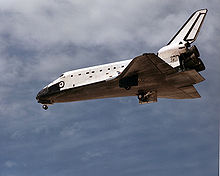
Picture - Atlantis deploys the landing gear before landing on a selected runway just like a common aircraft.
The shuttle was one of the earliest craft to use a computerized fly-by-wire digital flight control system. This means no mechanical or hydraulic linkages connect the pilot's control stick to the control surfaces or reaction control system thrusters.
A primary concern with digital fly-by-wire systems is reliability. Much research went into the shuttle computer system. The shuttle uses five identical redundant IBM 32-bit general purpose computers (GPCs), model AP-101, constituting a type of embedded system. Four computers run specialized software called the Primary Avionics Software System (PASS). A fifth backup computer runs separate software called the Backup Flight System (BFS). Collectively they are called the Data Processing System (DPS).
The design goal of the shuttle's DPS is fail-operational/fail-safe reliability. After a single failure, the shuttle can still continue the mission. After two failures, it can still land safely.
The four general-purpose computers operate essentially in lockstep, checking each other. If one computer fails, the three functioning computers "vote" it out of the system. This isolates it from vehicle control. If a second computer of the three remaining fails, the two functioning computers vote it out. In the rare case of two out of four computers simultaneously failing (a two-two split), one group is picked at random.
The Backup Flight System (BFS) is separately developed software running on the fifth computer, used only if the entire four-computer primary system fails. The BFS was created because although the four primary computers are hardware redundant, they all run the same software, so a generic software problem could crash all of them. Embedded system avionic software is developed under totally different conditions from public commercial software: the number of code lines is tiny compared to a public commercial software, changes are only made infrequently and with extensive testing, and many programming and test personnel work on the small amount of computer code. However, in theory it can still fail, and the BFS exists for that contingency. While BFS will run in parallel with PASS, to date, BFS has never been engaged to take over control from PASS during any shuttle mission.
The software for the shuttle computers is written in a high-level language called HAL/S, somewhat similar to PL/I. It is specifically designed for a real time embedded system environment.
The IBM AP-101 computers originally had about 424 kilobytes of magnetic core memory each. The CPU could process about 400,000 instructions per second. They have no hard disk drive, and load software from magnetic tape cartridges.
In 1990, the original computers were replaced with an upgraded model AP-101S, which has about 2.5 times the memory capacity (about 1 megabyte) and three times the processor speed (about 1.2 million instructions per second). The memory was changed from magnetic core to semiconductor with battery backup.
Early shuttle missions, starting in November 1983, took along the GRiD Compass, arguably one of the first laptop computers. The GRiD was given the name SPOC, for Shuttle Portable Onboard Computer. Use on the Shuttle required both hardware and software modifications which were incorporated into later versions of the commercial product. It was used to monitor and display the Shuttle's ground position, path of the next two orbits, show where the shuttle had line of sight communications with ground stations, and determine points for location-specific observations of the Earth. The Compass sold poorly, as it cost at least US$8000, but it offered unmatched performance for its weight and size. NASA was one of its main customers.
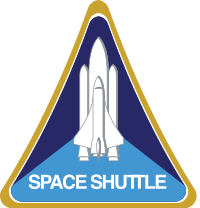
Picture - Space Shuttle program insignia
Markings and insignia
The typeface used on the Space Shuttle Orbiter is Helvetica. On the side of the shuttle between the cockpit windows and the cargo bay doors is the name of the orbiter. Underneath the rear of the cargo bay doors is the NASA insignia, the text 'United States' and a flag of the United States. Another United States flag appears on the right wing.
Upgrades
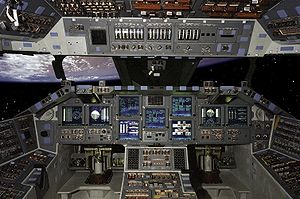
Picture - During STS-101, Atlantis was the first shuttle to fly with a glass cockpit.
The Space Shuttle was initially developed in the 1970s-era but has received many upgrades and modifications since then for improvements ranging from performance and reliability to safety. Internally, the shuttle remains largely similar to the original design, with the exception of the improved avionics computers. In addition to the computer upgrades, the original analog primary flight instruments were replaced with modern full-color, flat-panel display screens, similar to those of contemporary airliners like the Airbus A380 and Boeing 777. This is called a glass cockpit. With the coming of the ISS, the orbiter's internal airlocks have been replaced with external docking systems to allow for a greater amount of cargo to be stored on the shuttle's mid-deck during station resupply missions.
The Space Shuttle Main Engines (SSMEs) have had several improvements to enhance reliability and power. This explains phrases such as "Main engines throttling up to 104%." This does not mean the engines are being run over a safe limit. The 100% figure is the original specified power level. During the lengthy development program, Rocketdyne determined the engine was capable of safe reliable operation at 104% of the originally specified thrust. They could have rescaled the output number, saying in essence 104% is now 100%. To clarify this would have required revising much previous documentation and software, so the 104% number was retained. SSME upgrades are denoted as "block numbers", such as block I, block II, and block IIA. The upgrades have improved engine reliability, maintainability and performance. The 109% thrust level was finally reached in flight hardware with the Block II engines in 2001. The normal maximum throttle is 104%, with 106% or 109% used for mission aborts.
For the first two missions, STS-1 and STS-2, the external tank was painted white to protect the insulation that covers much of the tank, but improvements and testing showed that it was not required. The weight saved by not painting the tank results in an increase in payload capability to orbit. Additional weight was saved by removing some of the internal "stringers" in the hydrogen tank that proved unnecessary. The resulting "light-weight external tank" has been used on the vast majority of shuttle missions. STS-91 saw the first flight of the "super light-weight external tank". This version of the tank is made of the 2195 aluminum-lithium alloy. It weighs 3.4 metric tons (7,500 lb) less than the last run of lightweight tanks. As the shuttle cannot fly unmanned, each of these improvements has been "tested" on operational flights.
The SRBs (Solid Rocket Boosters) have undergone improvements as well. Design engineers added a third O-ring seal to the joints between the segments after the Space Shuttle Challenger disaster.
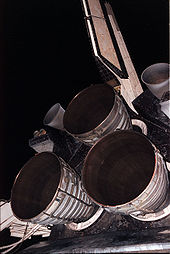
Picture - The three nozzles of the Main Engine cluster with the two Orbital Maneuvering System (OMS) pods, and the vertical stabilizer above.
Several other SRB improvements were planned in order to improve performance and safety, but never came to be. These culminated in the considerably simpler, lower cost, probably safer and better performing Advanced Solid Rocket Booster. These rockets entered production in the early to mid-1990s to support the Space Station, but were later canceled to save money after the expenditure of $2.2 billion. The loss of the ASRB program resulted in the development of the Super LightWeight external Tank (SLWT), which provides some of the increased payload capability, while not providing any of the safety improvements. In addition, the Air Force developed their own much lighter single-piece SRB design using a filament-wound system, but this too was canceled.
STS-70 was delayed in 1995, when woodpeckers bored holes in the foam insulation of Discovery's external tank. Since then, NASA has installed commercial plastic owl decoys and inflatable owl balloons which must be removed prior to launch. The delicate nature of the foam insulation has been the cause of damage to the Thermal Protection System, the tile heat shield and heat wrap of the orbiter, during recent launches. NASA remains confident that this damage, while it was the primary cause of the Space Shuttle Columbia disaster on February 1, 2003, will not jeopardize the objective of NASA to complete the International Space Station (ISS) in the projected time allotted.

Picture - Space Shuttle orbiter illustration
A cargo-only, unmanned variant of the shuttle has been variously proposed, and rejected since the 1980s. It was called the Shuttle-C, and would have traded re-usability for cargo capability, with large potential savings from reusing technology developed for the Space Shuttle.
On the first four shuttle missions, astronauts wore modified U.S. Air Force high-altitude full-pressure suits, which included a full-pressure helmet during ascent and descent. From the fifth flight, STS-5, until the loss of Challenger, one-piece light blue nomex flight suits and partial-pressure helmets were worn. A less-bulky, partial-pressure version of the high-altitude pressure suits with a helmet was reinstated when shuttle flights resumed in 1988. The Launch-Entry Suit ended its service life in late 1995, and was replaced by the full-pressure Advanced Crew Escape Suit (ACES), which resembles the Gemini space suit in design, but retains the orange color connected to the Launch-Entry Suit.
To extend the duration that orbiters can stay docked at the ISS, the Station-to-Shuttle Power Transfer System (SSPTS) was installed. The SSPTS allows these orbiters to use power provided by the ISS to preserve their consumables. The SSPTS was first used successfully on STS-118.
Technical data
Picture - Space Shuttle drawing
Orbiter specifications (for Endeavour, OV-105)
Length: 122.17 ft (37.237 m)
Wingspan: 78.06 ft (23.79 m)
Height: 58.58 ft (17.86 m)
Empty weight: 172,000 lb (78,000 kg)
Gross liftoff weight: 240,000 lb (110,000 kg)
Maximum landing weight: 230,000 lb (100,000 kg)
Maximum payload: 55,250 lb (25,060 kg)
Payload to LEO: 53,600 lb (24,310 kg)
Payload to LEO (ISS):
Payload to GTO: 8,390 lb (3,806 kg)
Payload to Polar Orbit: 28,000 lb (12,700 kg)
Payload bay dimensions: 15 by 59 ft (4.6 by 18 m)
Operational altitude: 100 to 520 nmi (190 to 960 km; 120 to 600 mi)
Speed: 7,743 m/s (27,870 km/h; 17,320 mph)
Crossrange: 1,085 nmi (2,009 km; 1,249 mi)
First Stage (SSME with external tank)
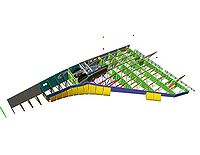
Main engines: Three Rocketdyne Block II SSMEs, each with a sea level thrust of 393,800 lbf (1.752 MN) at 104% power Thrust (at liftoff, sea level, 104% power, all 3 engines): 1,181,400 lbf (5.255 MN) Specific impulse: 455 s Burn time: 480 s Fuel: Liquid Oxygen/Liquid Hydrogen
Main engines: Three Rocketdyne Block II SSMEs, each with a sea level thrust of 393,800 lbf (1.752 MN) at 104% power
Thrust (at liftoff, sea level, 104% power, all 3 engines): 1,181,400 lbf (5.255 MN)
Specific impulse: 455 s
Burn time: 480 s
Fuel: Liquid Oxygen/Liquid Hydrogen
Second Stage
Picture - Space Shuttle wing cutaway

Picture - Space Shuttle Orbiter and Soyuz-TM (drawn to scale).
Engines: 2 Orbital Maneuvering Engines Thrust: 53.4 kN (12,000 lbf) combined total vacuum thrust Specific impulse: 316 s Burn time: 1250 s Fuel: MMH/N2O4
Engines: 2 Orbital Maneuvering Engines
Thrust: 53.4 kN (12,000 lbf) combined total vacuum thrust
Specific impulse: 316 s
Burn time: 1250 s
Fuel: MMH/N2O4
Crew: Varies.
The earliest shuttle flights had the minimum crew of two; many later missions a crew of five. Today, typically seven people fly (commander, pilot, several mission specialists, and rarely a flight engineer). On two occasions, eight astronauts have flown (STS-61-A, STS-71). Eleven people could be accommodated in an emergency mission (see STS-3xx).
The earliest shuttle flights had the minimum crew of two; many later missions a crew of five. Today, typically seven people fly (commander, pilot, several mission specialists, and rarely a flight engineer). On two occasions, eight astronauts have flown (STS-61-A, STS-71). Eleven people could be accommodated in an emergency mission (see STS-3xx).
External tank specifications (for SLWT)
Length: 46.9 m (154 ft)
Diameter: 8.4 m (28 ft)
Propellant volume: 2,025 m (534,900 US gal)
Empty weight: 26,535 kg (58,500 lb)
Gross liftoff weight: 756,000 kg (1,670,000 lb)
Solid Rocket Booster specifications
Length: 45.46 m (149 ft)
Diameter: 3.71 m (12.2 ft)
Empty weight (per booster): 68,000 kg (150,000 lb)
Gross liftoff weight (per booster): 571,000 kg (1,260,000 lb)
Thrust (at liftoff, sea level, per booster): 12.5 MN (2,800,000 lbf)
Specific impulse: 269 s
Burn time: 124 s
System Stack specifications
Height: 56 m (180 ft)
Gross liftoff weight: 2,000,000 kg (4,400,000 lb)
Total liftoff thrust: 30.16 MN (6,780,000 lbf)
Risk contributors
An example of technical risk analysis for a STS mission is SPRA iteration 3.1 top risk contributors for STS-133:
(1) MMOD orbit strikes
(2) SSME-induced SSME catastrophic failure
(3) ascent debris strikes to TPS leading to LOCV on orbit or entry
(4) crew error during entry
(5) RSRM-induced RSRM catastrophic failure
(6) COPV failure
Mission profile

Picture - STS mission profile
Launch
All Space Shuttle missions are launched from Kennedy Space Center (KSC). The weather criteria used for launch include, but are not limited to: precipitation, temperatures, cloud cover, lightning forecast, wind, and humidity. The shuttle will not be launched under conditions where it could be struck by lightning. Aircraft are often struck by lightning with no adverse effects because the electricity of the strike is dissipated through its conductive structure and the aircraft is not electrically grounded. Like most jet airliners, the shuttle is mainly constructed of conductive aluminum, which would normally shield and protect the internal systems. However, upon takeoff the shuttle sends out a long exhaust plume as it ascends, and this plume can trigger lightning by providing a current path to ground. The NASA Anvil Rule for a shuttle launch states that an anvil cloud cannot appear within a distance of 10 nautical miles. The Shuttle Launch Weather Officer will monitor conditions until the final decision to scrub a launch is announced. In addition, the weather conditions must be acceptable at one of the Transatlantic Abort Landing sites (one of several Space Shuttle abort modes) to launch as well as the solid rocket booster recovery area. While the shuttle might safely endure a lightning strike, a similar strike caused problems on Apollo 12, so for safety NASA chooses not to launch the shuttle if lightning is possible (NPR8715.5).
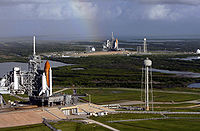
Picture - Two Space Shuttles sit at launch pads. This particular occasion is due to the final Hubble servicing mission, where the International Space Station is unreachable, which necessitates having a Shuttle on standby for a possible rescue mission.
Historically, the Shuttle was not launched if its flight would run from December to January (a year-end rollover or YERO). Its flight software, designed in the 1970s, was not designed for this, and would require the orbiter's computers be reset through a change of year, which could cause a glitch while in orbit. In 2007, NASA engineers devised a solution so Shuttle flights could cross the year-end boundary.
On the day of a launch, after the final hold in the countdown at T minus 9 minutes, the Shuttle goes through its final preparations for launch, and the countdown is automatically controlled by the Ground Launch Sequencer (GLS), software at the Launch Control Center, which stops the count if it senses a critical problem with any of the Shuttle's on-board systems. The GLS hands off the count to the Shuttle's on-board computers at T minus 31 seconds, in a process called auto sequence start.
At T minus 16 seconds, the massive sound suppression system (SPS) begins to drench the Mobile Launcher Platform (MLP) and SRB trenches with 300,000 US gallons (1,100 m) of water to protect the Orbiter from damage by acoustical energy and rocket exhaust reflected from the flame trench and MLP during liftoff.
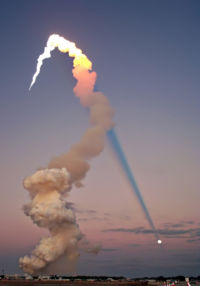
Picture - Shuttle launch of Atlantis at sunset in 2001. The sun is behind the camera, and the plume's shadow intersects the moon across the sky.
At T-minus 10 seconds, hydrogen igniters are activated under each engine bell to quell the stagnant gas inside the cones before ignition. Failure to burn these gases can trip the onboard sensors and create the possibility of an overpressure and explosion of the vehicle during the firing phase. The main engine turbopumps also begin charging the combustion chambers with liquid hydrogen and liquid oxygen at this time. The computers reciprocate this action by allowing the redundant computer systems to begin the firing phase.
The three Space Shuttle Main Engines (SSMEs) start at T minus 6.6 seconds. The main engines ignite sequentially via the shuttle's general purpose computers (GPCs) at 120 millisecond intervals. The GPCs require that the engines reach 90% of their rated performance to complete the final gimbal of the main engine nozzles to liftoff configuration. When the SSMEs start, the water from the sound suppression system flashes into a large volume of steam that shoots southward. All three SSMEs must reach the required 100% thrust within three seconds, otherwise the onboard computers will initiate an RSLS abort. If the onboard computers verify normal thrust buildup, at T minus 0 seconds, the 8 pyrotechnic nuts holding the vehicle to the pad are detonated and the SRBs are ignited. At this point the vehicle is committed to takeoff, as the SRBs cannot be turned off once ignited. The plume from the solid rockets exits the flame trench in a northward direction at near the speed of sound, often causing a rippling of shockwaves along the actual flame and smoke contrails. At ignition, the GPCs mandate the firing sequences via the Master Events Controller, a computer program integrated with the shuttle's four redundant computer systems. There are extensive emergency procedures (abort modes) to handle various failure scenarios during ascent. Many of these concern SSME failures, since that is the most complex and highly stressed component. After the Challenger disaster, there were extensive upgrades to the abort modes.
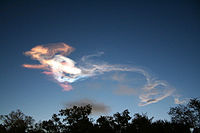
Picture - Multicolored afterglow of the STS-131 launch
After the main engines start, but while the solid rocket boosters are still clamped to the pad, the offset thrust from the Shuttle's three main engines causes the entire launch stack (boosters, tank and shuttle) to pitch down about 2 m at cockpit level. This motion is called the "nod", or "twang" in NASA jargon. As the boosters flex back into their original shape, the launch stack pitches slowly back upright. This takes approximately six seconds. At the point when it is perfectly vertical, the boosters ignite and the launch commences. The Johnson Space Center's Mission Control Center assumes control of the flight once the SRBs have cleared the launch tower.
Shortly after clearing the tower the Shuttle begins a combined roll, pitch and yaw maneuver that positions the orbiter head down, with wings level and aligned with the launch pad. The Shuttle flies upside down during the ascent phase. This orientation allows a trim angle of attack that is favorable for aerodynamic loads during the region of high dynamic pressure, resulting in a net positive load factor, as well as providing the flight crew with use of the ground as a visual reference. The vehicle climbs in a progressively flattening arc, accelerating as the weight of the SRBs and main tank decrease. To achieve low orbit requires much more horizontal than vertical acceleration. This is not visually obvious, since the vehicle rises vertically and is out of sight for most of the horizontal acceleration. The near circular orbital velocity at the 380 kilometers (236 mi) altitude of the International Space Station is 7.68 kilometers per second 27,650 km/h (17,180 mph), roughly equivalent to Mach 23 at sea level. As the International Space Station orbits at an inclination of 51.6 degrees, the Shuttle has to set its inclination to the same value to rendezvous with the station.
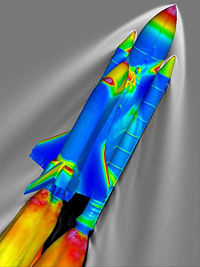
Picture - SSLV at Mach 2.46 and 66,000 ft (20,000 m). The surface of the vehicle is colored by the pressure coefficient, and the gray contours represent the density of the surrounding air, as calculated using the overflow codes.
Around a point called Max Q, where the aerodynamic forces are at their maximum, the main engines are temporarily throttled back to 72% to avoid overspeeding and hence overstressing the Shuttle, particularly in vulnerable areas such as the wings. At this point, a phenomenon known as the Prandtl-Glauert singularity occurs, where condensation clouds form during the vehicle's transition to supersonic speed. At T+70 seconds, the main engines throttle up to their maximum cruise thrust of 104% rated thrust.
At T+126 seconds after launch, explosive bolts release the SRBs and small separation rockets push them laterally away from the vehicle. The SRBs parachute back to the ocean to be reused. The Shuttle then begins accelerating to orbit on the Space Shuttle main engines. The vehicle at that point in the flight has a thrust-to-weight ratio of less than one - the main engines actually have insufficient thrust to exceed the force of gravity, and the vertical speed given to it by the SRBs temporarily decreases. However, as the burn continues, the weight of the propellant decreases and the thrust-to-weight ratio exceeds 1 again and the ever-lighter vehicle then continues to accelerate towards orbit.
The vehicle continues to climb and takes on a somewhat nose-up angle to the horizon - it uses the main engines to gain and then maintain altitude while it accelerates horizontally towards orbit. At about five and three-quarter minutes into ascent, the orbiter's direct communication links with the ground begin to fade, at which point it rolls heads up to reroute its communication links to the Tracking and Data Relay Satellite system.
Finally, in the last tens of seconds of the main engine burn, the mass of the vehicle is low enough that the engines must be throttled back to limit vehicle acceleration to 3 g (29.34 m/s²), largely for astronaut comfort.
The main engines are shut down before complete depletion of propellant, as running dry would destroy the engines. The oxygen supply is terminated before the hydrogen supply, as the SSMEs react unfavorably to other shutdown modes. (Liquid oxygen has a tendency to react violently, and supports combustion when it encounters hot engine metal.) The external tank is released by firing explosive bolts and falls, largely burning up in the atmosphere, though some fragments fall into the ocean, in either the Indian Ocean or the Pacific Ocean depending on launch profile. The sealing action of the tank plumbing and lack of pressure relief systems on the external tank helps it break up in the lower atmosphere. After the foam burns away during reentry, the heat causes a pressure buildup in the remaining liquid oxygen and hydrogen until the tank explodes. This ensures that any pieces that fall back to Earth are small.
To prevent the shuttle from following the external tank back into the lower atmosphere, the Orbital maneuvering system (OMS) engines are fired to raise the perigee higher into the upper atmosphere. On some missions (e.g., missions to the ISS), the OMS engines are also used while the main engines are still firing. The reason for putting the orbiter on a path that brings it back to Earth is not just for external tank disposal but also one of safety: if the OMS malfunctions, or the cargo bay doors cannot open for some reason, the shuttle is already on a path to return to earth for an emergency abort landing.
In orbit
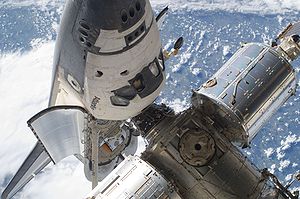
Picture - Atlantis & Harmony - Spring 2010
Once in orbit, the shuttle does any number of tasks, and usually some combination. In the 1980s and 1990s, many flights involved space science missions on the NASA/ESA Spacelab, or launching various types of satellites and science probes. By the 1990s and 2000s the focus shifted more to servicing space stations, with fewer satellite launches. Most missions involve staying in orbit several days to two weeks, although longer missions are possible with the Extended Duration Orbiter add-on or when attached to a space station.
Re-entry and landing
Almost the entire Space Shuttle re-entry procedure, except for lowering the landing gear and deploying the air data probes, is normally performed under computer control. However, the re-entry can be flown entirely manually if an emergency arises. The approach and landing phase can be controlled by the autopilot, but is usually hand flown.
The vehicle begins re-entry by firing the Orbital maneuvering system engines, while flying upside down, backside first, in the opposite direction to orbital motion for approximately three minutes, which reduces the shuttle's velocity by about 200 mph (322 km/h). The resultant slowing of the Shuttle lowers its orbital perigee down into the upper atmosphere. The shuttle then flips over, by pushing its nose down (which is actually "up" relative to the Earth, because it is flying upside down). This OMS firing is done roughly halfway around the globe from the landing site.
The vehicle starts encountering more significant air density in the lower thermosphere at about 400,000 ft (120 km), at around Mach 25, 8,200 m/s (30,000 km/h; 18,000 mph). The vehicle is controlled by a combination of RCS thrusters and control surfaces, to fly at a 40 degree nose-up attitude, producing high drag, not only to slow it down to landing speed, but also to reduce reentry heating. As the vehicle encounters progressively denser air, it begins a gradual transition from spacecraft to aircraft. In a straight line, its 40 degree nose-up attitude would cause the descent angle to flatten-out, or even rise. The vehicle therefore performs a series of four steep S-shaped banking turns, each lasting several minutes, at up to 70 degrees of bank, while still maintaining the 40 degree angle of attack. In this way it dissipates speed sideways rather than upwards. This occurs during the 'hottest' phase of re-entry, when the heat-shield glows red and the G-forces are at their highest. By the end of the last turn, the transition to aircraft is almost complete. The vehicle levels its wings, lowers its nose into a shallow dive and begins its approach to the landing site.
Simulation of the outside of the Shuttle as it heats up to over 1,500 °C during re-entry.
A Space Shuttle model undergoes a wind tunnel test in 1975. This test is simulating the ionized gasses that surround a shuttle as it reenters the atmosphere.
A computer simulation of high velocity air flow around the Space Shuttle during re-entry.
The orbiter's maximum glide ratio/lift-to-drag ratio varies considerably with speed, ranging from 1:1 at hypersonic speeds, 2:1 at supersonic speeds and reaching 4.5:1 at subsonic speeds during approach and landing.
In the lower atmosphere, the orbiter flies much like a conventional glider, except for a much higher descent rate, over 50 m/s (180 km/h; 110 mph). At approximately Mach 3, two air data probes, located on the left and right sides of the orbiter's forward lower fuselage, are deployed to sense air pressure related to the vehicle's movement in the atmosphere.
When the approach and landing phase begins, the orbiter is at a 3,000 m (9,800 ft) altitude, 12 km (7.5 mi) from the runway. The pilots apply aerodynamic braking to help slow down the vehicle. The orbiter's speed is reduced from 682 to 346 km/h (424 to 215 mph), approximately, at touch-down (compared to 260 km/h (160 mph) for a jet airliner). The landing gear is deployed while the Orbiter is flying at 430 km/h (270 mph). To assist the speed brakes, a 12 m (39 ft) drag chute is deployed either after main gear or nose gear touchdown (depending on selected chute deploy mode) at about 343 km/h (213 mph). The chute is jettisoned once the orbiter slows to 110 km/h (68.4 mph).
After landing, the vehicle stands on the runway for several minutes to permit the fumes from poisonous hydrazine (which is used as a fuel for attitude control, and the orbiter's three APUs) to dissipate, and for the shuttle fuselage to cool before the astronauts disembark.
Discovery touches down at the end of STS-95.
Columbia lands at Kennedy Space Center at the end of STS-73.
Endeavour brake chute deploys after touching down
Discovery after landing on Earth for crew disembarkment
Landing sites
NASA prefers Space Shuttle landings to be at Kennedy Space Center. If weather conditions make landing there unfavorable, the shuttle can delay its landing until conditions are favorable, touch down at Edwards Air Force Base, California, or use one of the multiple alternate landing sites around the world. A landing at any site other than Kennedy Space Center means that after touchdown the shuttle must be mated to the Shuttle Carrier Aircraft and returned to Cape Canaveral. Space Shuttle Columbia (STS-3) landed at the White Sands Space Harbor, New Mexico; this is viewed as a last resort as NASA scientists believe that the sand could potentially damage the shuttle's exterior.
There are many alternative landing sites that have never been used.
Fleet history

Picture - OV-101 Enterprise takes flight for the first time over Dryden Flight Research Facility, Edwards, California in 1977 as part of the Shuttle program's Approach and Landing Tests (ALT).
Below is a list of major events in the Space Shuttle orbiter fleet.
Sources: NASA launch manifest, NASA Space Shuttle archive
Shuttle disasters
On January 28, 1986, Space Shuttle Challenger disintegrated 73 seconds after launch due to the failure of the right SRB, killing all seven astronauts on board. The disaster was caused by low-temperature impairment of an SRB O-ring, a mission critical component. Repeated warnings from design engineers voicing concerns about the lack of evidence of the O-rings' safety when the temperature was below 53 °F (12 °C) were ignored by NASA managers.
On February 1, 2003, Space Shuttle Columbia disintegrated during re-entry, killing its crew of seven, because of damage to the carbon-carbon leading edge of the wing caused during launch. Ground control engineers had made three separate requests for high-resolution images taken by the Department of Defense that would have provided an understanding of the extent of the damage, while NASA's chief thermal protection system (TPS) engineer requested that astronauts on board the Columbia be allowed to leave the vehicle to inspect the damage. NASA managers intervened to stop the Department of Defense's assistance and refused the request for the spacewalk, and thus the feasibility of scenarios for astronaut repair or rescue by the Space Shuttle Atlantis were not considered by NASA management at the time.
Retirement and legacy
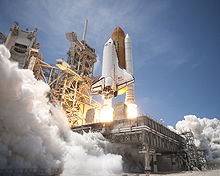
Picture - Space Shuttle Atlantis lifts off from Launch Pad 39A at NASA's Kennedy Space Center in Florida on the STS-132 mission to the International Space Station at 2:20 p.m. EDT on May 14. The last scheduled flight of Atlantis before it is retired.
NASA's current plans call for the Space Shuttle to be retired from service in 2011, after nearly 30 years of service. Under the current plans, Atlantis will be the first of NASA's three remaining operational Space Shuttles to be retired as the program winds down. To fill the void left by the Shuttle's retirement, a new spacecraft is being developed to ferry not only passengers and cargo to the ISS but also to travel beyond Earth orbit to the Moon and Mars. Originally called the Crew Exploration Vehicle, the concept has evolved into the Orion spacecraft and the project named Project Constellation.
President Obama's administration in Feb 2010 proposed eliminating public funds for the Constellation program and shifting the burden for developing a replacement low-orbit service to private corporations. Until another launch vehicle is ready, crews would travel to and from the International Space Station aboard Russian Soyuz spacecraft or possibly a future American commercial spacecraft. However, President Obama's plan must be approved by the United States Congress, and counter-proposals are currently being considered by Congress, including the potential extension of the Space Shuttle program for an additional five years while a replacement can be developed. The proposed cancellation of Project Constellation in February 2010 was signed into law October 11, 2010.
Michael Suffredini of the ISS program has said that one additional trip will be needed in 2011 to deliver parts to the International Space Station. The Space Shuttle was originally to be retired in late 2010, but has been extended until April 2011 according to the NASA launch and mission schedule
Final locations of retired orbiters
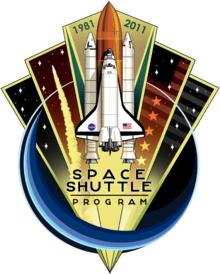
Picture - Space Shuttle Program commemorative patch
Discovery has already been promised to the Smithsonian Institution's National Air and Space Museum in the Udvar Hazy Center, and Atlantis, Endeavour, and Enterprise are planned to be transferred to other education institutions or museums with the museum covering the $28.8 million cost of preparing and transporting each vehicle for display. Twenty museums have submitted proposals for displaying one of the retired orbiters, including:
Kennedy Space Center Visitor Complex, Orbiter Processing Facility, Cape Canaveral, Florida
Space Center Houston, Johnson Space Center, Houston, Texas
National Museum of the United States Air Force, Dayton, Ohio
U.S. Space & Rocket Center, Huntsville, Alabama
Intrepid Sea, Air & Space Museum, New York, New York
Museum of Flight, Seattle, Washington
Evergreen Aviation & Space Museum, McMinnville, Oregon
Tulsa Air and Space Museum, Tulsa, Oklahoma
Flight and mid-deck training hardware from the Johnson Spaceflight Center will go to the National Air and Space Museum and the National Museum of the U.S. Air Force. The full fuselage mockup, which includes the payload bay and aft section but no wings, is to go to the Museum of Flight in Seattle, which has already broken ground on its new building to house the artifact. Mission Simulation and Training Facility's fixed simulator will go to the Adler Planetarium in Chicago, and the motion simulator will go to Texas A&M's Aerospace Engineering Department in College Station, Texas. Other simulators used in shuttle astronaut training will go to the Wings of Dreams Aviation Museum in Starke, Florida and the Virginia Air and Space Center in Hampton, Virginia.
NASA is also donating Space Shuttle thermal protection system tiles to schools and universities for $23.40 each. About 7,000 tiles are available on a first-come, first-served basis, but limited to one each per institution.
Commercial replacement vehicles and services
NASA announced the awarding of contracts for the cargo resupply of the International Space Station (ISS) to SpaceX and Orbital Sciences Corporation on December 23, 2008. SpaceX will use its Falcon 9 launch vehicle and Dragon spacecraft. Orbital Sciences will use its Taurus II launch vehicle and Cygnus spacecraft.
Technology transfer
Even though the Space Shuttle program is retiring, NASA and the USAF have been transferring Space Shuttle technology to other programs:
Launch vehicles
Shuttle-Derived Launch Vehicles, including Heavy Lift Launch Vehicles, have been proposed. For example, designs for the Ares I and Ares V have been integrated into meeting those challenges set forth within the Vision for Space Exploration; though the Constellation program was discontinued in October 2010.
Next-generation orbiters
The USAF's Boeing X-37 program represents a next-generation of unmanned reusable spaceplanes. The X-37 reuses the basic aerodynamic lifting body shape of the Space Shuttle Orbiter. According to Deputy Under Secretary of the Air Force (International Affairs) Gary Payton, the X-37 is a "test" for the next-generation beyond the Space Shuttle, designed to remain in orbit for up to 9 months at a time.
In culture
The Space Shuttle has played an important role in various works of fiction. Early examples include the 1979 James Bond film, Moonraker where shuttles played a major role well before any were actually launched, Activision videogame Space Shuttle: A Journey into Space (1982) and G. Harry Stine's novel Shuttle Down (1981). In the 1986 family film SpaceCamp, the Atlantis accidentally launches into space with children as its crew. Retired American test pilots visit a Russian satellite in the Clint Eastwood adventure film Space Cowboys (2000). On television, the 1996 drama The Cape portrays the lives of a group of NASA astronauts as they prepare for and fly shuttle missions.
The Space Shuttle has also been the subject of toys and models, for example a large Lego Space Shuttle model was constructed by visitors at Kennedy Space Center.
U.S. Postage commemorations
The U.S. Post Office has released several postage issues that depict the Space Shuttle. The first such stamps were issued in 1981, and are on display at the National Postal Museum.
Chrysler SERV
Criticism of the Space Shuttle program
Getaway Special
List of human spaceflights
List of Space Shuttle crews
NASA TV: View live streaming of launch and mission coverage
Orbiter Processing Facility
Shuttle Training Aircraft
Space accidents and incidents
HL-20 Personnel Launch System
Physics
Atmospheric reentry
Lifting body
Reusable launch system
Single-stage-to-orbit
Similar spacecraft
Buran program 1974-1992
Comparison of heavy lift launch systems
DIRECT, a shuttle-derived vehicle proposed as an alternative for Project Constellation
X-20 Dyna-Soar 1957-1963
EADS Phoenix
Hermes 1975-1992
HOPE-X
Kliper
Lockheed Martin X-33 1995-2001
Military space shuttle
Orion (Project Constellation)
Further reading
NSTS 1988 Reference manual
How The Space Shuttle Works
NASA Space Shuttle News Reference - 1981 (PDF document)
Orbiter Vehicles
Lecture Series on the space shuttle from MIT OpenCourseWare
Space Shuttle Pictures and Space Shuttle for Sale.
Living Warbirds: The best warbirds DVD series.
Source: WikiPedia